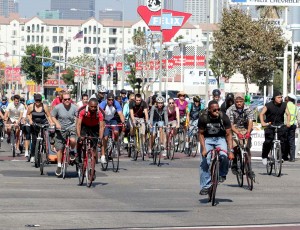CicLAvia bikers pass by USC area for first time
Thousands of people made their way through more than nine miles of car-free Downtown L.A. streets Sunday in celebration of the fifth CicLAvia event, which was the first time the event passed by the University Park Campus.

Movement · Thousands of bicyclists pedal down Figueroa Street on Sunday as part of the fifth CicLAvia event. Officials closed more than nine miles of Downtown L.A. streets. – Austin Vogel | Daily Trojan
The semi-annual event derives its name from ciclovía, a weekly street closure event in Colombia that translates to “bike way.” The event came to fruition as a result of people from the bicycling, environmental community and urban planning communities coming together and creating an event in Los Angeles in the same vein as the Bogota phenomenon.
Organizers estimated that more than 100,000 participants bicycled in Sunday’s CicLAvia.
Though the event had some residents worried about the potential imposition to traffic flow, David Galaviz, executive director of USC Local Government Relations, said the big picture positives outweigh the nuisance.
“We see this as a great opportunity to really enhance not only university-community relationships citywide, but also neighbor-to-neighbor relationships throughout the entire city,” Galaviz said. “The university been a supporter of CicLAvia for a long time. We’re not in the business of stopping events.”
Los Angeles’ own “bike way” began in 2010 and, despite the issue of traffic, Aaron Paley, president of Community Arts Resources and staff member of CicLAvia, said the event has received overwhelmingly positive feedback since its start.
“We understand that for many people that this event is an imposition, and we’re appreciative of their forbearance of it,” Paley said. “However, this is such an overwhelmingly positive thing and it provides such a great opportunity for tens of thousands of Angelenos. We hope that the kind of general good outweighs the difficulty that it causes.”
While Sunday’s event was the fifth CicLAvia event, it was the first to travel south, passing by the University Park Campus and eventually ending at Exposition Park.
“There was a group of activists in South L.A. that were really hoping to bring CicLAvia into South L.A.,” Paley said. “We did have a route that went down Central Avenue, but we couldn’t get past Washington because of the Blue Line railroad tracks. Since we couldn’t go down Central to get to South L.A., we looked at other opportunities and realized that Figueroa was fantastic. It’s a straight shot and we hit USC, Exposition Park and all these other great things along the way.”
Besides coordinating the traffic implications of the event, CicLAvia organizers also worked with USC to get the campus involved.
“We have been meeting with [CicLAvia organizers] over the course of a few months to ensure that transportation services were aware that this was going on,” Galaviz said. “In turn, they asked us to make sure as much as possible that we informed the university community that this was happening on campus — to let students know that this was occurring and also to encourage them to participate.”
Jacqueline Ramirez, a student studying public health with USC’s Keck School of Medicine, recently got involved with CicLAvia as a part of a project and hopes to bring the various health benefits of the event to light.
“When I was doing research for my own project, I thought ‘someone is already doing it — might as well join forces,’” Ramirez said. “I came in as a public health student saying, ‘Hey, this is a public health event. Let’s emphasize that aspect of it.’”
Ramirez also added that she hopes to see a big USC presence at future events.
“We’re a biking community within the campus — now, students should learn to navigate themselves through L.A., which can be an overwhelming task,” Ramirez said. “It’s important that students get involved because we have our creative minds. We see an event, and we see what we could do to improve it. Not one single person can get something done.”
Paley encouraged participants to take the healthy lifestyle the event seeks to promote and adapt it to their lives.
“Our message is that this is a great city that you can enjoy in other ways besides your car,” Paley said. “If you discover it beyond your car, you’ll see that it’s actually a much more intimate and exciting city than you even imagined.”

Comments are closed.